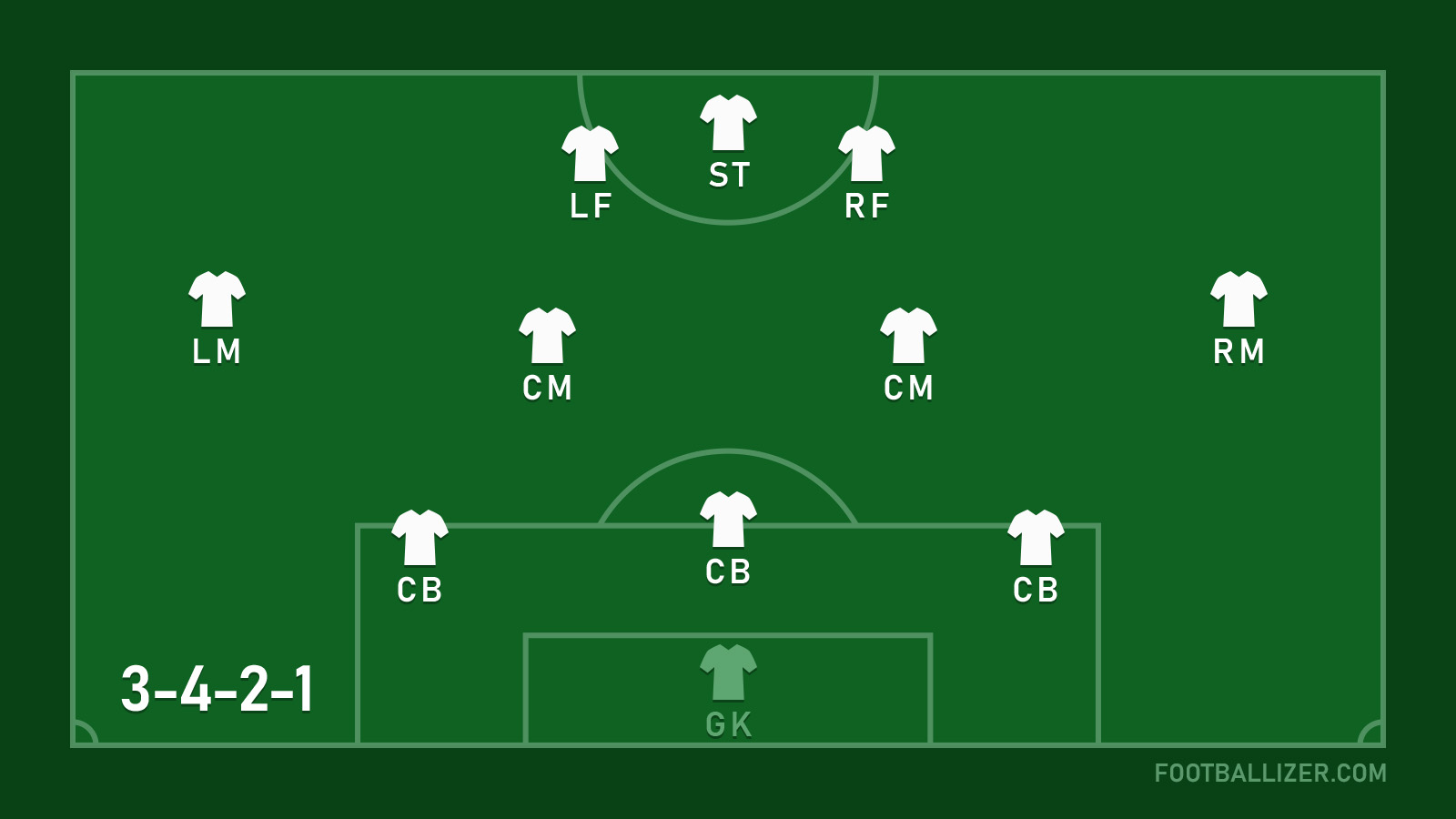3-4-2-1 Formation

Three central defenders, four midfielders, and three attacking players make up the popular tactical system known as the 3-4-2-1 in football. This formations is appropriate for the games you're attempting to win by maintaining the ball in the middle and having your midfielders create opportunities.
The 3-4-2-1 is typically set up with the three central defenders forming a solid defensive line in the back, with the two outer defenders pushing up the field to support the midfielders in wide areas. The four midfielders are then divided into two central midfielders and two wide midfielders, who are responsible for supporting both the defense and the attack. The two attacking players (LF, RF) typically play behind the lone striker (ST), and their job is to create scoring opportunities for themselves and the striker.
Three centre backs, four midfielders, and three strikers make up the 3-4-2-1 configuration. The three center-backs form a solid defensive line, while the four midfielders provide support to both the defense and attack. The three forwards are responsible for scoring goals and creating chances in the final third.
Strengths
The 3-4-2-1 configuration is favoured by football managers and coaches for a number of reasons, including:
Strong Midfield
With four midfielders, the 3-4-2-1 formation provides a strong presence in the midfield. This can help the team to control possession of the ball, create scoring opportunities, and prevent the opposition from getting too much time on the ball.
Defensive Stability
While the 3-4-2-1 formation only has three defenders, the two wing-backs can provide additional cover in wide areas. This can make it difficult for the opposition to get in behind the defense and create scoring opportunities.
Attacking Flexibility
The two attacking midfielders can provide a variety of attacking options. They can create scoring opportunities for themselves and the striker, play one-twos with other attackers, or even drop back to help build up play from midfield.
Counter-attacking Potential
The 3-4-2-1 formation can be effective at counter-attacking. With a strong midfield presence, the team can quickly win the ball back and break forward in numbers.
Fluidity and Adaptability
The 3-4-2-1 formation is a flexible formation that can be adapted to suit the strengths and weaknesses of the opposition. For example, the team can switch to a more defensive formation by dropping one of the attacking midfielders back into midfield, or switch to a more attacking formation by pushing one of the central midfielders forward.
Weaknesses
Vulnerable to Counter-attacks
With only three defenders, the team may be vulnerable to quick counter-attacks from the opposition. If the opposition is able to win the ball and quickly transition into attack, there may be fewer defenders available to stop them.
Limited Width
While the two wing-backs can provide width in the attacking phase, they may leave gaps in the defense when pushing forward. This can be exploited by the opposition if they are able to win the ball and quickly counter-attack.
Midfield overload
While the 3-4-2-1 formation can provide a strong midfield presence, it can also result in an overcrowded midfield. If the opposition is able to defend well and limit the space available in midfield, the team may struggle to create scoring opportunities.
Striker Isolation
The lone striker in the 3-4-2-1 formation may become isolated if the attacking midfielders are not able to provide adequate support. If the opposition is able to mark the attacking midfielders effectively, the striker may struggle to get involved in the game.
Requires Specific Player Attributes
This football formation requires specific player attributes, such as strong and versatile midfielders who can defend and attack, and wing-backs who are comfortable pushing forward and providing width. If the team does not have the right players for this formation, it may not be effective.
How to Counter 3-4-2-1 Formation?
Using the disadvantage of this formation and creativity from the coach, several strategies can be used to counter the 3-4-2-1, such as the following:
Overload the flanks: The 3-4-2-1 formation is vulnerable to attacks down the flanks because the wing-backs often push forward to provide width in attack. By overloading the flanks with two or three players, a team can exploit the gaps left by the wing-backs and create scoring opportunities.
Exploit the space in midfield: The 3-4-2-1 formation can become overcrowded in midfield, which can limit the team's ability to create scoring opportunities. By exploiting the space between the central midfielders and the central defenders, a team can create chances for their attackers to run into and score.
Press high up the pitch: The 3-4-2-1 formation relies on controlling the midfield and building attacks from the back. By pressing high up the pitch and disrupting the team's build-up play, a team can force turnovers and create scoring opportunities.
Switch to a different formation: If a team is struggling to break down the 3-4-2-1 formation, they can switch to a different formation that better suits their strengths. For example, a team could switch to a 4-3-3 formation to provide more width and exploit the gaps left by the wing-backs.
Direct play: The 3-4-2-1 formation may have trouble dealing with long balls and aerial crosses. A team can avoid the midfield and put pressure on the goalkeeper and centre defenders by playing direct.